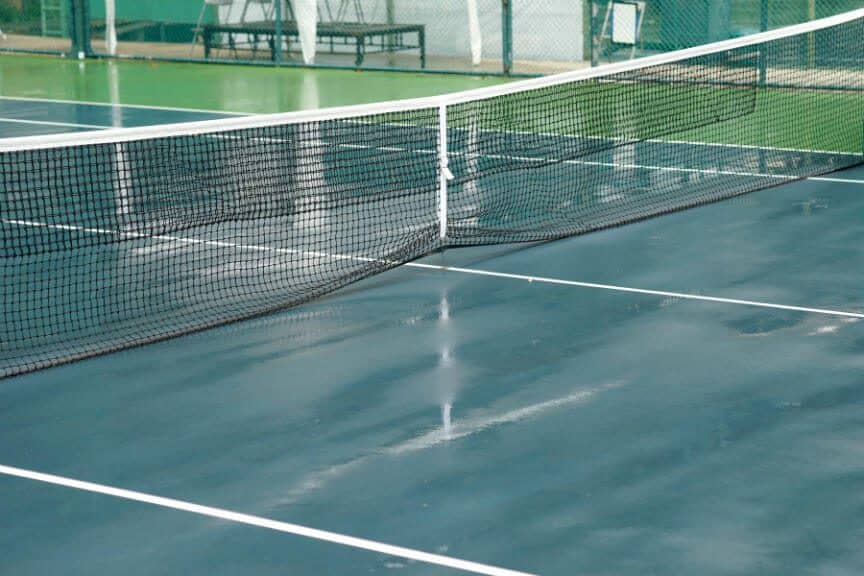If you’ve watched a few professional Grand Slam matches in your life, then you are used to the notion that when it rains the game of tennis stops. But outside of the professional circuit, is it possible to play tennis in the rain?
To answer this, first, let’s take a look at why professional matches are stopped in the first place. The primary reason is to protect the players from injury and to protect the courts, particularly on clay and grass. A wet and slippery court is a playing hazard for professional players playing at maximum intensity.
Outside of the pro circuit, tennis matches often take place in the rain. Unless conditions are extreme, oftentimes tournaments have stipulations that games will be played rain or shine. Friendly matches are of course optional, and in most cases, players would choose not to play under wet conditions, however, if players chose to do so, it is possible to play in the rain as long as conditions are not too extreme.
There are parts of the world where rain is so prevalent year-round that not playing in the rain would mean hardly ever playing tennis, particularly if indoor courts are not available, which oftentimes they are not.
Playing Under Wet Conditions
Playing tennis in the rain is not the best experience. Balls get very heavy and soggy. Moving around the court requires a greater degree of caution. You may find that you damage your strings more easily, particularly if they are natural gut when playing under wet conditions.
That said, there are times when you just need to get out and play. There is nothing inherently wrong with playing or practicing in the rain as long as you exercise reasonable caution. Pay closer attention to your footwork, you will not be able to move around as freely.
Exercise Caution and Come Prepared
In light rain, you should be o.k. In a heavy downpour, you are better off avoiding playing. If you hear thunder, head for your car or inside a building and wait at least 20 minutes after it has stopped. Alternatively, pack up your belongings and return to play another day.
If you chose to play under wet conditions, bring equipment and gear that will help keep you and your equipment more dry. Here is a list of items that you can bring with you when playing tennis in the rain to improve your experience.
Bring a Towel to Wipe Your Racket
Your racket is going to get wet when playing in the rain, you need to have a dry towel with you to wipe it down, particularly the handle/grip. A towel is also useful to wipe yourself down with. Use towels to keep your face and arms dry.
When you are done using the towel, store it in a protective bag to keep it dry. It will get soggy after a while, so you may want to bring a couple of towels. Keeping the grip dry is important to avoid the handle from slipping out of your hand.
Use a Visor or Cap to Help Keep Rain Away from Your Eyes
For better visibility and to help keep some water out of your face, bring a visor or cap with you. Keeping rain away from your eyes can improve your performance under these conditions. This will go a long way in helping with visibility.
Caps have the added advantage that they can keep your head somewhat dry as well. There are even caps available that are specifically water-resistant for use in these conditions. Columbia makes a watertight cap that you can find on Amazon.
Wear a Thin Rain Jacket
You should also bring a thin rain jacket with you to avoid getting drenched. Just make sure that it’s not too bulky and will not interfere with your ability to play. You also don’t want it to be so thick that it becomes hot and uncomfortable.
Columbia also makes a rain jacket that is thin and not too restricting on movement during play. If you decide to rough it out and not wear a jacket, at least bring an extra shirt that you can change into after playing.
Wear Shoes with Good Grip
This is perhaps the most important aspect of playing in the rain. When tennis courts are wet they can be slippery. A pair of tennis shoes with good grip can help, but you will still be more prone to slipping and injuring yourself, so use caution when playing under these conditions.
It may seem somewhat counterintuitive, but it’s best to avoid playing too intensely in these situations to avoid slipping. Better to let a ball go than to injure yourself and not be able to play for a period of time. Make sure your feet and balance are stable as you run throughout the court.
Bring a Few Extra Balls
Tennis balls get heavy and soggy in the rain. They will not bounce as high and will require greater pace on shots to clear the net. Balls will also feel heavy on contact because they will absorb water and moisture.
All of this can make playing in the rain an unpleasant experience, but you can bring a few extra balls and regularly rotate them during play once they start to get too soggy. Keep them in a bag until you use them so that they remain dry.
Avoid Using Rackets Strung with Natural Gut
While nylon, polyester, and Kevlar strings hold up fine in the rain, you should not use natural gut in wet conditions. The strings will at the very least lose tension and possibly break during play as they become stretched.
Those who are used to the feel of natural gut will find switching to a synthetic string to be difficult, but doing so will help protect your racket. You can use a synthetic gut in place of natural gut in these circumstances.
Store Your Equipment in Protective Bags Before and After Playing
In order to keep your equipment protected and dry, bring a bag that you can store your rackets, tennis balls, a towel, and other gear in. At the very least it will help avoid additional exposure to the elements.
If you are able to temporarily place your bags under an enclosed, roofed area, do so to avoid the bag itself from getting soaked. If not, the bag should help to keep your gear relatively dry. Opt for a waterproof bag if at all possible.
Closing Comments
Since many tournaments are played rain or shine, it might be a good idea to get out there from time to time and play in rainy conditions. This will allow you to be better prepared if you ever find yourself in a competitive situation where you have to play in the rain.
Just be sure to come prepared with extra gear to help you get through it all. You will need to adjust your style of play under rainy or wet conditions. Since balls will be heavier and not bounce as high, you will need to adjust your swing or bend your knees more.
You will also need to swing harder at the ball since it will feel heavier. You may need to adjust the motion on your serve as well. Like on your groundstrokes, you will need to swing harder and adjust the toss since the ball will be heavier.
While not the best experience, playing in the rain is certainly possible. Sometimes there is no alternative. If you do have indoor courts in your general vicinity, you are better off scheduling them in advance as they will get filled quickly.
Share this Post

